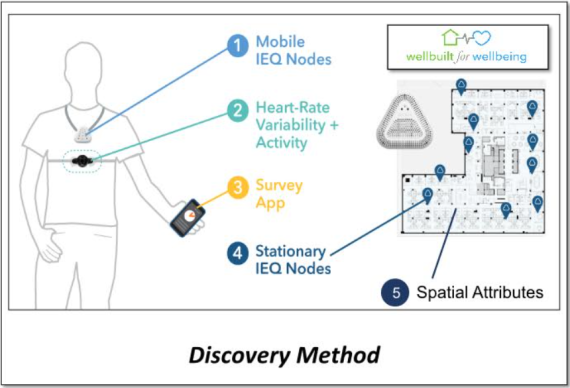The Office of Federal High-Performance Buildings’ Wellbuilt for Wellbeing research project was designed to help GSA better understand the influence of the office environment on human health, comfort and performance. Our findings are influencing the way GSA approaches the design and operation of work spaces and will inform the future design of federal buildings. Since we spend 90% of our time indoors this perspective is critical.
Denver Federal Building Study
Wellbuilt for Wellbeing builds on prior GSA-sponsored research which found that employees working in a newly renovated section of a federal office building had lower physiological stress response (as measured by wearable sensors) than a similar group working in an unrenovated space. Improvements in sound, daylight, and window views correlated with reduced stress, but the research could not determine the relative importance of these factors or other unmeasured aspects of the space. Significant advancements in real-time sensing technology paved the way for Wellbuilt for Wellbeing by enabling the collection of accurate, simultaneous measures of employee physiological health outcomes, psychological wellbeing, and environmental conditions.
Discovery Method
Wellbuilt for Wellbeing used a “discovery method” to explore potential interactions between human health and the widest range of indoor environmental factors ever captured in the field in real time. Our interdisciplinary team used innovative sensing technologies, including wearable devices, to measure human health outcomes and environmental conditions in real time as employees went about their normal work. We then used advanced analytic methods to identify environmental levers (office layout, humidity, sound and CO2 levels) that might reduce stress, improve sleep and increase physical activity. We did not limit ourselves to testing a single hypothesis but kept our eyes open for any possible relationships.
Our Findings
Physical activity was 32% higher in open offices.
- Observation: Open offices related to more physical activity at work and less stress after working hours.
- Health Implication: Chronic stress impacts long-term health and increases the frequency and severity of viral infection.
- Design Implication: Provide well ventilated open office areas with many choices of work, meeting and support spaces to reduce sedentary behavior and related chronic health conditions.
- Results: Occupational and Environmental Medicine 7/2018
Stress was 25% higher in dry air.
- Observation: Exposure to dry air related to higher stress and poorer sleep than moderately humid air.
- Health Implication: Chronic stress and poor sleep impact long-term health and increase the frequency and severity of viral infection.
- Design Implication: Humidify buildings with well designed envelopes and encourage “micro-breaks” to mitigate dry eyes, inflammation, infection and fatigue.
- Results: Indoor Air Journal 1/2020; Enhancing Health with Indoor Air
CO2 is higher in your personal cloud.
Air quality can vary a lot across a building.
- Observation: Small, densely-occupied meeting and focus rooms have higher and more variable CO2 levels than larger, less-dense open office spaces.
- Health Implication: Higher CO2 has been linked to decreased cognitive performance, and is associated with increased discomfort and fatigue.
- Design Implication: Design for higher ventilation rates based on likely occupancy in those spaces or provide continuous room-level measurement.
- Results: Conference Proceedings, Indoor Air 2018, Philadelphia (See conference papers 257, 338, 470, 680, 720, and 834; free after 7/2020);Enhancing Health with Indoor Air
Too much or too little noise is stressful.
- Observation: Moderate sound levels (around 50dBA) related to less stress than louder or quieter conditions.
- Health Implication: Chronic stress and poor sleep impact long-term health and increase the frequency and severity of viral infection.
- Design Implication: Designing open offices that allow quiet conversation with sound masking or “cover” strategies may reduce stress.
- Results: npj | digital medicine, 2023; See GSA Sound Matters [PDF - 3 MB].
Personality matters to design.
- Observation: Self-rated introverts are more likely to report trouble focusing in open office areas than extroverts.
- Design Implication: An appropriate mix of concentrative spaces should be included in open office design.
- Results: Journal of Research in Personality, 2023.
The indoor environment can tell you when a space is occupied.
Sleep is complex but it can be measured objectively outside the lab.
- Observation: Using the Pittsburgh Sleep Quality Index (PSQI), the gold standard survey tool for evaluating quality of sleep by individuals, and the objective measurements for actual sleep quality available through chest-mounted accelerometers, we developed the Sensor Based Sleep Quality Index (SB-SQI) to provide an overall objective measure for the very complex topic of how sleep quality varies in different conditions.
- Results: Paper in Preprint, 2018.
What steps can you take now to improve your own health at work?
Break up your day with “micro-breaks!”
- Spend 10-20 seconds every half hour looking away from your monitor; too much screen-time increases dry eye symptoms and fatigue.
- Stand up and walk around; sitting a long time without getting up increases stress and simple movement can be as beneficial as the gym
- Spend your break outside; fresh air can improve focus and decision making; and 30 minutes of daylight, especially in the morning, is great for circadian stimulus.
Stay hydrated!
- Add water to your breaks; you may not feel thirsty but water loss happens continuously through the skin and contributes to fatigue, inflammation and infection.
Make comfort personal, it is not one-size-fits-all!
- How might changes in dress, location in the building, or using personal devices like a small fan or foot warmer improve how comfortable the temperature feels?
- Where are places in the office where you feel best able to focus, can you go there when you need to get things done?
- Does using a fan to provide air movement help you concentrate on tasks?
The Future
While the discovery method allowed our team to be open to unexpected connections between the indoor environment and health, we do not offer our findings as definitive proof. They suggest areas for further study that have a significant likelihood of improving human health through the built environment. The Wellbuilt for Wellbeing Project Team will continue to develop ours and other research findings going forward.
Acknowledgements
This project was a collaboration between the U.S. General Services Administration, the University of Arizona, the Baylor College of Medicine, and Aclima Inc. The Wellbuilt for Wellbeing Project Team include: Kevin Kampschroer, Judith Heerwagen and Brian Gilligan of GSA. Esther Sternberg, Perry Skeath, Casey Lindberg, and Matthias Mehlof the University of Arizona Institute on Place, Wellbeing and Performance. Bijan Najafi, Javad Razjouyan, Hyoki Lee, and Hung Nguyen of the Baylor College of Medicine Interdisciplinary Consortium on Advanced Motion Performance. Sudha Ram, Faiz Curim and Karthik Srinivasian of the University of Arizona INSITE Center for Business Intelligence and Analytics. Kelli Canada of LMI Priya Saha, Rebecca Goldfinger-Fein, Alicia Darbishire, and Mills Wallace of the Federal Occupational Health Service. Davida Herzl, Reuben Herzl, Melissa Lunden, Nicole Goebel, and Scott Andrews of Aclima Inc.
In addition, numerous contributors have provided input as acknowledged in our journal articles. Special thanks are given to all the federal workers who accepted to be volunteers for the purpose of this study. None of the volunteers received funding or other compensation for participation in this study. The Wellbuilt for Wellbeing Project Team wish to thank the following individuals for providing advice on our findings and potential confounds: Ed Ahrens, Seema Bhangar, Alyse Falconer, Traci Hanegan,Mark Hydeman, Kevin Hydes, Vivian Loftness, Melissa Lunden, Piers McNaughton, Forrest Meggers, Gwelen Paliaga, Jovan Pantelic, Chris Pyke, Stephanie Taylor, and Steven Taylor.

 U.S. General Services Administration
U.S. General Services Administration








